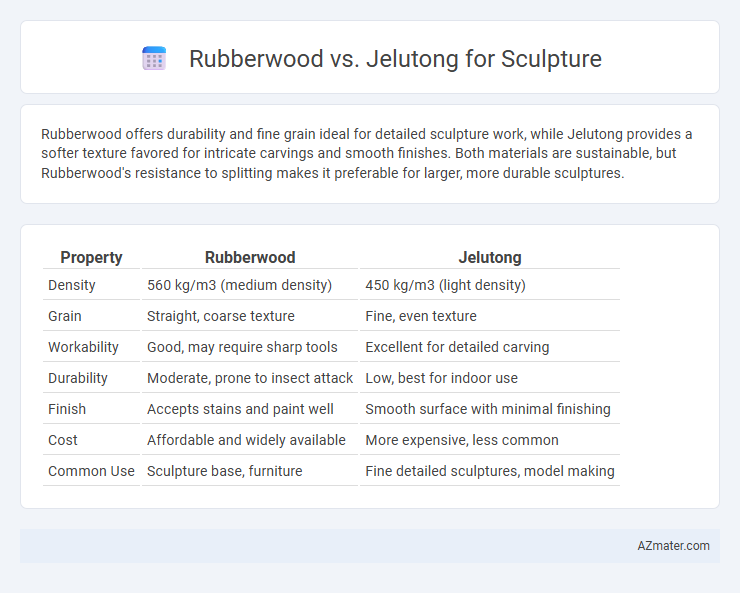Rubberwood offers durability and fine grain ideal for detailed sculpture work, while Jelutong provides a softer texture favored for intricate carvings and smooth finishes. Both materials are sustainable, but Rubberwood's resistance to splitting makes it preferable for larger, more durable sculptures.
Table of Comparison
| Property | Rubberwood | Jelutong |
|---|---|---|
| Density | 560 kg/m3 (medium density) | 450 kg/m3 (light density) |
| Grain | Straight, coarse texture | Fine, even texture |
| Workability | Good, may require sharp tools | Excellent for detailed carving |
| Durability | Moderate, prone to insect attack | Low, best for indoor use |
| Finish | Accepts stains and paint well | Smooth surface with minimal finishing |
| Cost | Affordable and widely available | More expensive, less common |
| Common Use | Sculpture base, furniture | Fine detailed sculptures, model making |
Introduction to Rubberwood and Jelutong
Rubberwood, harvested from the Para rubber tree (Hevea brasiliensis), is valued for its durability, fine grain, and resistance to warping, making it a popular choice for sculptures requiring strength and detailed carving. Jelutong, sourced from the Dyera costulata tree native to Southeast Asia, offers a softer texture and smooth surface, ideal for intricate sculpting and detailed finishes. Both woods are favored by artisans, with rubberwood providing robustness and jelutong excelling in workability and fine detail.
Origin and Availability of Rubberwood
Rubberwood originates primarily from Southeast Asia, especially Malaysia and Thailand, where it is harvested from rubber trees after their latex production declines, making it a sustainable choice for sculptors. Its availability is abundant due to the extensive rubber plantations, offering a consistent supply compared to Jelutong, which is sourced from the Jelutong tree native to Borneo but is less widespread. The high availability of Rubberwood combined with its moderate hardness makes it a preferred material for detailed carving and sculptural work.
Origin and Availability of Jelutong
Jelutong wood originates from Southeast Asia, primarily Malaysia and Indonesia, where it grows abundantly in tropical rainforests, making it largely available in these regions. Its fine, even texture and light color are highly favored for detailed sculpting, especially in traditional and commercial carving industries. Compared to rubberwood, which is a byproduct of the rubber industry and more widely distributed in plantations, jelutong's consistent quality and natural availability make it a preferred choice for precision sculpture work.
Physical Characteristics Comparison
Rubberwood offers a medium density of around 560 kg/m3 with a coarse grain and moderate hardness, making it suitable for detailed carving and durability in sculptures. Jelutong has a lighter density near 450 kg/m3 and a fine, uniform grain that carves smoothly but is softer, which may lead to easier damage during intricate work. Both woods have low resin content, enhancing their workability and finish quality, but Rubberwood's higher hardness provides better resistance to wear in finished sculptures.
Workability for Sculptors
Rubberwood offers excellent workability with its fine, straight grain and moderate hardness, making it ideal for detailed carving in sculpture. Jelutong is favored for its soft texture and uniform grain, allowing smooth cuts and fine detail work with minimal tool resistance. Both woods are lightweight and stable, but Rubberwood's durability provides longer-lasting sculptures while Jelutong is easier to shape for intricate designs.
Durability and Lifespan
Rubberwood offers moderate durability with a lifespan of 15 to 25 years when properly treated, making it a popular choice for sculptors seeking affordability and availability. Jelutong wood, known for its fine grain and ease of carving, has a lower natural durability and a shorter lifespan, typically lasting around 10 to 15 years before signs of wear emerge. For long-lasting sculptures exposed to environmental factors, Rubberwood proves more resilient and better suited for outdoor or high-traffic display environments.
Finishing and Surface Quality
Rubberwood offers a smooth, tight grain that accepts finishes evenly, resulting in a durable, polished surface ideal for detailed sculptures. Jelutong's fine, straight grain provides a soft texture that sands easily, allowing for intricate carving but may require more sealing to achieve a high-quality finish. Both woods deliver excellent surface quality, but Rubberwood tends to have better resistance to moisture, enhancing the longevity of finished sculptures.
Environmental Impact and Sustainability
Rubberwood is derived from rubber trees that have completed their latex-producing cycle, making it a sustainable choice by utilizing plantation timber that would otherwise be discarded. Jelutong is harvested from slow-growing tropical hardwood forests, leading to concerns about deforestation and habitat loss, thus posing a higher environmental impact. The renewable nature of rubberwood, combined with its ability to be reclaimed from plantations, positions it as a more eco-friendly option for sculptors prioritizing environmental responsibility.
Cost and Accessibility
Rubberwood offers a cost-effective option for sculptors due to its widespread availability as a byproduct of the rubber industry, resulting in lower prices compared to Jelutong. Jelutong, prized for its fine grain and ease of carving, tends to be more expensive and less accessible because it is harvested less frequently and sourced primarily from Southeast Asia. Sculptors seeking affordable material with decent workability often prefer Rubberwood, while those prioritizing smooth finishes and detailed carving invest in Jelutong despite its higher cost and limited supply.
Best Applications for Sculpture
Rubberwood offers dense, uniform grain ideal for detailed and durable sculptures, making it perfect for fine carving and intricate designs. Jelutong is softer with a fine texture, preferred for smooth finishes and delicate work such as figurines and small decorative pieces. Both woods are lightweight and easy to work with, but Rubberwood's hardness suits larger, more robust sculptures while Jelutong excels in lightweight, detailed artistry.

Infographic: Rubberwood vs Jelutong for Sculpture
 azmater.com
azmater.com